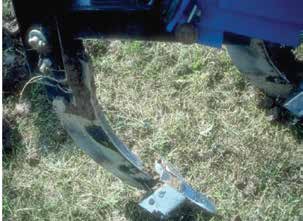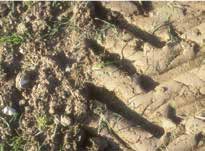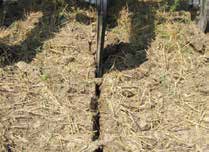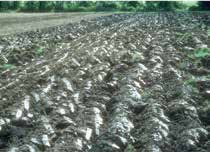chAPter 15 Preventing and lessening CoMPaCtion
Figure 15.4. Tools that provide compaction relief with minimal soil disturbance: aerator (left) and strip tiller (right). Right photo by Bob Schindelbeck.
especially effective for promoting root proliferation.
practice that is difficult to justify for use on a regular
Another approach may be to combine organic matter
basis. Practices such as zone building also loosen the
additions (compost, manure, etc.) with reduced tillage
soil below the plow layer, but zone builders have narrow
intensity (for example, chisel plows with straight points,
shanks that disturb the soil less and leave crop residues
or chisel plows specifically designed for high-residue con-
on the surface (figure 15.5).
ditions) and a planter that ensures good seed placement
Deep tillage may be beneficial on soils that have
with minimal secondary tillage. Such a soil management
developed a plow pan. Simply shattering this pan allows
system builds organic matter over the long term.
for deeper root exploration. To be effective, deep tillage
Deep tillage (subsoiling) is a method to alleviate
needs to be performed when the entire depth of tillage
compaction below the 6- to 8-inch depths of normal
is sufficiently dry and in the friable state. The practice
tillage and is often done with heavy-duty rippers (figure
tends to be more effective on coarse-textured soils
15.5) and large tractors. Subsoiling is often erroneously
(sands, gravels), as crops on those soils respond bet-
seen as a cure for all types of soil compaction, but it
ter to deeper rooting. In fine-textured soils, the entire
does relatively little to address plow layer compaction.
subsoil often has high strength values, so the effects of
Subsoiling is a rather costly and energy-consuming
deep tillage are less beneficial. In some cases it may even
Lessening and preventing soil compaction are important to improving soil health. The specific approaches should meet the following criteria:
• They should be selected based on where the compaction problem occurs (subsoil, plow layer, or surface).
• They must fit the soil and cropping system and their physical and economic realities.
• They should be influenced by other management choices, such as tillage system and use of organic matter amendments.
165
Building SoilS for Better CropS: SuStainaBle Soil ManageMent













